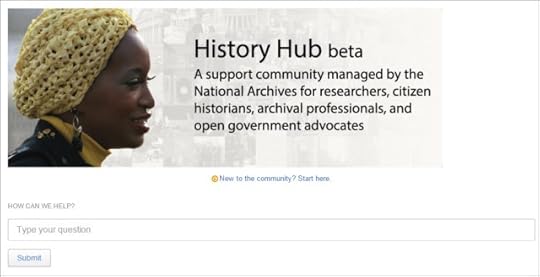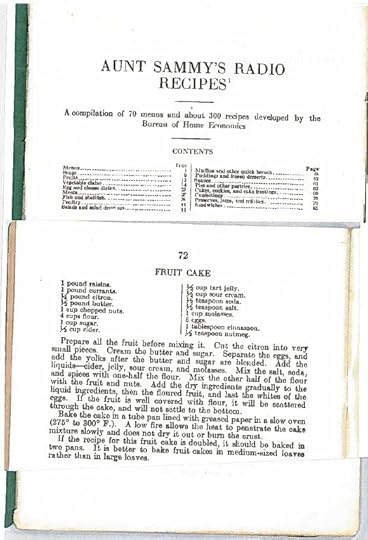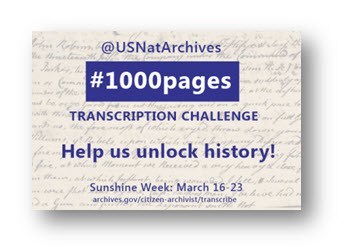David S. Ferriero's Blog, page 21
February 4, 2016
#ColorOurCollections
In celebration of the New York Academy of Medicine’s #ColorOurCollections campaign this week, many museums, libraries, and archives hopped on the adult coloring bandwagon and created coloring books to share on Twitter. We’ve been participating by posting various images throughout the week for people to color, from Rosie the Riveter to the Faulkner murals.
Now we have a coloring book as well! We’ve chosen some of our favorite patents from our holdings for you to color:
The National Archives Coloring Book of Patents 2016
Or, browse our online catalog for more fascinating patents to color!
Share your coloring creations with us on Twitter using the hashtag #ColorOurCollections.

January 21, 2016
Cabin Fever Remedies
Much of the Eastern Seaboard is bracing for a major snow/ice event this weekend. Are you prepared? Looking for indoor activities?
Even if you can’t make it out to the research rooms, you can still do something fun and good for the country from the comfort of your own home as you tag and transcribe records from the National Archives. Your tags and transcriptions will help make our catalog easier to search.
With snow on our minds, we’ve created a few winter-themed tagging missions on our Citizen Archivist Dashboard.

Agent’s House. Department of Commerce. Bureau of Fisheries. Division of Alaska Fisheries. 1913-7/1/1939. Series: Pribilof Islands Glass Plate Negatives, 1913 – 1921. National Archives Identifier: 23853701
And while you are on the Dashboard, take a look at the many other ways you can get involved. From tagging missions to transcribing documents, scanning photos to joining the conversation on History Hub, there is a way for everyone to participate and contribute.
Find something interesting? Share your contributions with us on Twitter @USNatArchives #ITaggedIt

January 13, 2016
Launch and Learn: Our New History Hub Pilot Project
I am pleased to announce a new pilot project from the Office of Innovation at the National Archives called the “History Hub.” This new platform may be thought of as an external collaboration network, a place where subject matter experts from the National Archives can engage with researchers and the public, to share information, work more easily together, and find people based on their experience and interests. The platform offers discussion boards, blogs, profiles, and other interactive tools for communication and collaboration.
We aim to use the History Hub to explore new ways of connecting with and serving customers interested in historical topics relating to our holdings. This project helps us to achieve NARA’s strategic goal to Connect with Customers, in particular, to expand public participation and our use of crowdsourcing tools. The project is also part of NARA’s Open Government Plan and supports the aim of achieving government transparency, as well as citizen participation and collaboration with the federal government. The History Hub provides us a platform for eventually working with other cultural organizations—such as the Smithsonian and the Library of Congress—to offer the public a one-stop shop for crowdsourcing information.
The History Hub is a limited six-month pilot project so that we can test the platform for its use and usefulness as a crowdsourcing platform. We will use the pilot period to benchmark level of effort on the part of NARA staff and to better understand public engagement metrics. We are developing a robust set of evaluation criteria to evaluate the pilot and ensure good use of NARA’s resources.
The History Hub project will include participation from staff subject matter experts who have both an interest and expertise in these topics. For the pilot, we are working on a narrow set of topics that have been identified as good test cases for this platform. For example, we know that the popularity and complexity of Native American research makes it a good candidate for discussion on this platform and NARA has an opportunity to collaborate with other federal resources, such as the Smithsonian, to better serve researchers.
The idea for this project has been under discussion for several years, and I am excited about the potential for this pilot project, as it is a great opportunity to engage National Archives staff experts, the public, as well as colleagues at other institutions to further NARA’s mission and strategic goals.
But we really don’t know how the History Hub will actually be used. We just know that all of our great plans for it will surely miss some of the new ways people will use the tool. That’s the nature of innovative projects, we need to launch and then learn from them.
Do you have research questions you’ve always wanted answered? Do you want advice on how to get started with genealogical research? Give it a try and ask a question at historyhub.archives.gov.

January 7, 2016
Releasing All We Can, Protecting What We Must
The Presidential Rank Award Program was created to recognize “sustained extraordinary accomplishment” by career senior executives in the Federal Government. In a highly competitive process, executives nominated by their agency heads are evaluated by citizen panels and designated by the President of the United States. Recipients are deemed to be strong leaders, professionals, or scientists who achieve results and consistently demonstrate strength, integrity, industry, and a relentless commitment to excellence in public service.
I am so pleased, proud, and honored that Sheryl J. Shenberger, Director of our National Declassification Center has been named a Meritorious Executive Presidential Rank Award recipient—the first National Archives and Records Administration executive to be so recognized.

Sheryl Shenberger, Director of the National Declassification Center. Photo courtesy of the Gulf Times
As the inaugural Director of the National Declassification Center, Sheryl is recognized as the Federal Government expert for executing the review, declassification, and release of permanent government records. Her accomplishments are an example of our commitment to the Administration’s Open Government Initiative. Her sustained leadership in coordination of the adjudication of multi-equity referrals as well as balancing transparency and openness with the protection of still-sensitive information is extremely important work.
Learn more about the National Declassification Center’s work at www.archives.gov/declassification/ndc

December 22, 2015
Happy Holidays from AOTUS!
Receipt for fruit cake, March 1918.
National Archives Identifier: 6233802 / Local Identifier: HST-BWT_5_3_03_01
This is a receipt for a fruit cake purchased by Bess Wallace at the Jones Store, a Kansas City, Missouri Department store, to send to her fiancé, Harry S. Truman, who was stationed in France with the United States Army 129th Field Artillery.
Fruit Cake recipe from Aunt Sammy’s Radio Recipes, Developed by The Bureau of Home Economics, 1927. From the Records of the U.S. Department of Agriculture.

November 20, 2015
Making Room for Those in Danger

The Refugee Act of 1980 is now on temporary display in the West Gallery of the National Archives Building. Photo by National Archives Photographer Jeffrey Reed.
At the end of the Vietnam War, hundreds of thousands of Vietnamese and Cambodians fled political chaos and physical danger in their homelands. Between 1975 and 1979, some 300,000 of these refugees were admitted to the United States through Presidential action. The law at the time restricted refugee admissions, and many members of Congress wanted to establish a more regular system of immigration and resettlement.
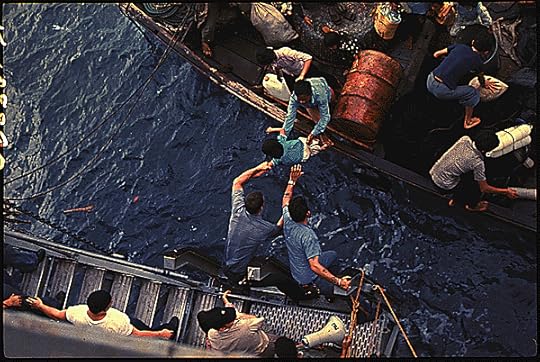
In the South China Sea, crewmen of the amphibious cargo ship USS Durham (LKA-114) take Vietnamese refugees aboard a small craft. The refugees will be transferred later by mechanized landing craft (LCM) to the freighter Transcolorado., 4/3/1975. General Records of the Department of the Navy, National Archives Identifier 558518
The Refugee Act of 1980 raised the annual ceiling for refugees to 50,000, created a process for reviewing and adjusting the refugee ceiling to meet emergencies, and required annual consultation between Congress and the President. The law changed the definition of “refugee” to a person with a “well-founded fear of persecution,” a standard established by United Nations conventions and protocols. It also funded a new Office of U.S. Coordinator for Refugee Affairs and an Office of Refugee Resettlement and built on already existing public-private partnerships that helped refugees settle and adjust to life in their new country.

A bill to amend the Immigration and Nationality Act to revise the procedures for the admission of refugees, to amend the Migration and Refugee Assistance Act of 1962 to establish a more uniform basis for the provision of assistance to refugees, and for other purposes, page one (Public Law 96-212—The Refugee Act of 1980), approved March 17, 1980
National Archives, General Records of the U.S. Government
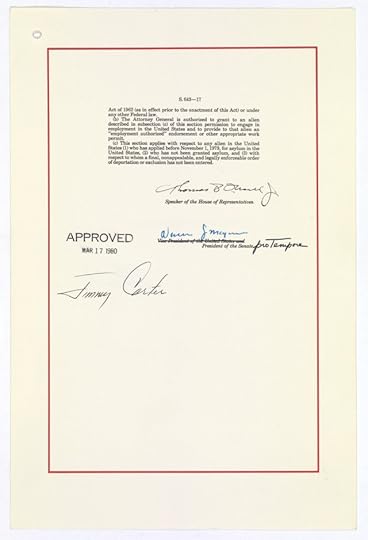
Signature page of The Refugee Act of 1980, approved March 17, 1980
National Archives, General Records of the U.S. Government.
View all pages of the Refugee Act of 1980 on the National Archives’ Flickr account: https://www.flickr.com/photos/usnationalarchives/sets/72157661462319371

November 3, 2015
2015 Records of Achievement Award
Last week, A’Lelia Bundles, the Chair and President of the National Archives Foundation, and I presented the 2015 National Archives Foundation Records of Achievement Award to Taylor Branch, an American author and Pulitzer Prize winner. This award recognizes Branch’s lifelong work chronicling the life of Dr. Martin Luther King, Jr. and the history of the Civil Rights movement in his landmark series: America in the King Years.
Taylor Branch’s Pulitzer Prize–winning narrative of the Civil Rights Movement has helped shape our understanding of that turbulent time in our history. He conducted extensive research at several National Archives facilities including the Eisenhower, Kennedy, and Johnson Presidential Libraries where he mined the notes of meetings, reviewed oral histories, and listened to countless hours of presidential recordings—all carefully collected, preserved, and made available by generations of National Archives staff.
The National Archives holds many records pertaining to Civil Rights, including March on Washington photographs, the Civil Rights Act of 1964, and the Voting Rights Act of 1965. We even have Taylor’s own Freedom of Information lawsuit against the FBI!
Taylor Branch’s work demonstrates the power of the stories preserved in the National Archives. We house the tangible reminders of where we have been, how far we have come, and see every day how these reminders inspire others to discover other important stories to share with the world.
Our partners at the National Archives Foundation share our passion for educating our citizens about the important work of the National Archives in preserving our history and making it accessible to the people. The Records of Achievement Award is the Foundation’s highest honor, and each year, the award itself includes facsimiles of records from the National Archives collection that is of special significance to our honoree.
This year, in recognition of Taylor Branch’s groundbreaking research on the Civil Rights Movement, we presented two facsimiles of a document that he sought under a 1986 Freedom of Information Act (FOIA) lawsuit against the FBI, Branch v. Federal Bureau of Investigation, Civil Action No. 86-1643.
The FOIA request was for classified records that the FBI had compiled between 1962 and 1963 on Stanley Levison, a friend and advisor to Dr. Martin Luther King, Jr. The first facsimile shows the heavily redacted page that was originally provided to Branch by the FBI. It is a 1962 memo from the FBI Director to the Attorney General concerning Dr. King.

1962 memo from the FBI Director to the Attorney General concerning Dr. King. This heavily redacted page was originally provided to Branch by the FBI.
This next facsimile shows the memo after it was recently declassified on September 18, 2015.
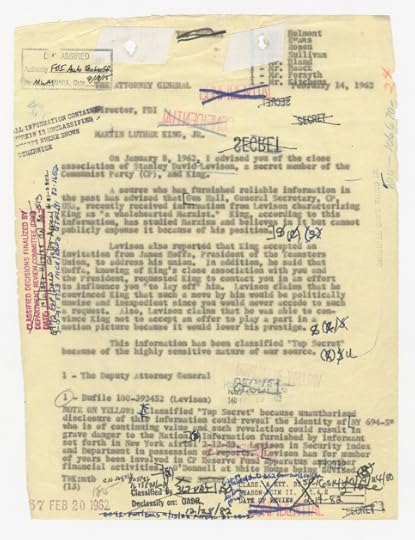
1962 memo from the FBI Director to the Attorney General concerning Dr. King, after it was declassified on September 18, 2015.
The facsimiles were accompanied by the Records of Achievement medallion, which is composed of bronze from the original document encasements which were removed from the Rotunda of the National Archives during the 2003 renovation.
We presented the award and the records to Taylor Branch as our tribute to his commitment to consulting primary sources as he continues to tell the stories of our nation’s history. Congratulations, Taylor.

October 30, 2015
By the Numbers: Digitization and Citizen Engagement
The National Archives’ Strategic Plan includes the ambitious initiative to digitize our analog records and make them available for online public access. With over 12 billion pages of records in our holdings, this is no small undertaking. As we work to make more of our holdings available online, it is also important to see how our researchers and customers interact with those records, invite them to contribute their unique knowledge and expertise, and ultimately make the records more searchable and accessible.
This third post in a series for American Archives Month explores our efforts to digitize the holdings of the National Archives, make them accessible online, and engage citizens.
Our recently updated digitization strategy outlines the various approaches we will use to achieve the goal of expanding public access through digitization, including continued collaboration with private and public organizations, citizen archivists, and other federal agencies to digitize records. We are developing clearer processes and improved technologies to support workflow from staff digitization efforts, as well as ensuring that records arriving at NARA are accompanied by standardized metadata, with the goal of making them available online in a shorter period of time. As a result of these efforts, the National Archives digitized and added more than 5 million digital objects to our online catalog in Fiscal Year 2015. Highlights of these newly digitized images include color photographs from the Battle of the Bulge, as well as images from World War I and World War II:

Wreckage in St. Vith, Belgium. National Archives Identifier 16730732

A.S.C. Women at Work. National Archives Identifier 16577208
To better facilitate access of records, our online catalog has also recently been upgraded and now features more participatory elements, including new tagging and transcription tools to further engage citizen archivists and help make our holdings more discoverable to researchers. At the end of the fiscal year, citizen archivists had contributed over 91,000 tags and 35,000 transcriptions to the catalog, with the latter growing at over 5% each week.
To introduce these new catalog features, we kicked off Sunshine Week this spring with a transcription challenge for citizen archivists. During that week alone, citizens transcribed more than 2,500 pages of records and added 10,000 new tags to the catalog, making our records more searchable and accessible to everyone.
Our efforts in digitization and citizen engagement are an important piece in achieving the goal of making access happen in the spirit of a more open government. Inviting participation, transparency and collaboration in all aspects of our work helps us provide more democratic access to our holdings for the benefit of all.
See my previous posts in this series on maximizing our value through web and social media and connecting with customers. And stay tuned for my final post in this series reflecting on the opportunities and challenges we see as we continue our efforts to make access happen.

October 29, 2015
National Action Plan 3.0
On Tuesday, the White House announced the release of the third U.S. Open Government National Action Plan in conjunction with the Open Government Partnership (OGP) Global Summit taking place in Mexico City this week. In her opening remarks to the summit, Samantha Power, the US Ambassador to the United Nations discussed the status of the OGP and open government around the world and the importance of civil society engagement and critique in the OGP.

Samantha Power at the opening ceremony for the Open Government Partnership Global Summit. Video of Power’s remarks begins here: https://youtu.be/cV9b9tMnKzY?t=20m51s
Several NARA staff members are participating in the OGP Global Summit this week and worked on the interagency development of the third NAP. The development included eight months of collaboration with Federal agencies and engagement with the public and civil society. NARA also hosted a public meeting on July 30, 2015, to engage the public in the development of third NAP.
The third U.S. Open Government National Action Plan (NAP) has more than 40 new or expanded initiatives to advance open government across federal agencies, including the National Archives. NARA’s commitments in the third NAP reflect our significant, ongoing work to strengthen open government. NARA’s commitments include:
Improve Management of Government Records
We will release a public dataset of positions of government increase transparency in the positions of government officials whose email will come to the National Archives for permanent preservation under the Capstone approach. We will introduce targeted questions regarding email management to agencies regarding their implementation of the Managing Government Records Directive and report on publicly on agencies’ progress, allowing stakeholders to track progress on agencies’ email management efforts. We will also seek feedback from civil society to improve NARA’s online repository of Records Control Schedules.
Modernize Implementation of the Freedom of Information Act
We will participate in a pilot program led by the Department of Justice (DOJ) to test the feasibility of posting FOIA-released records online so they are available to the public. NARA’s Office of Government Information Services (OGIS) and DOJ will also work to issue guidance and create best practices for agency FOIA web pages in order to encourage agencies to update their FOIA websites to be consistent, informative, and user-friendly. Additionally, we will work to increase the understanding of FOIA by developing tools to teach students about FOIA and develop resources that will be made available online.
Streamline the Declassification Process
NARA’s National Declassification Center (NDC) will implement a special systematic declassification review program for previously reviewed and exempted historical Federal records that were accessioned to the National Archives and reviewed prior to the creation of the NDC in 2010.
Implement the Controlled Unclassified Information Program
We will continue implementation of an open and unified program for managing unclassified information that requires safeguarding or dissemination control, known as Controlled Unclassified Information. We will issue implementation guidance, establish phased implementation schedules, publish an enhanced CUI Registry, and work with the Federal Acquisition Regulatory Council to propose a FAR rule.
Develop a Machine Readable Government Organizational Chart
The National Archives’ Office of Federal Register will work with the General Services Administration to facilitate access to information about government agencies and better leverage the underlying data published in the United States Government Manual.
Increase the Impact of Open Innovation Activities
We will expand our Citizen Archivist activities to include citizen scanning of the Federal records in our new Innovation Hub. This offers an opportunity to further our engagement in the public and collaborate to make our records more accessible through these digitization efforts.
While these are NARA’s topline commitments, we will be involved in the work of many more NAP commitments and we will also continue our work in implementing our agency’s third Open Government Plan, which reflects commitments throughout the agency to strengthen transparency, participation, and collaboration.

October 22, 2015
By the Numbers: Connecting with Customers in Person and Online
At the National Archives, we connect with customers in a multitude of ways: face-to-face, over the phone, across the desk, in our research rooms, in the classroom and of course, online. We serve a diverse set of customer communities, including educators, historians, genealogists, researchers, veterans and now groups such as civic hackers, Wikipedians and many more. To meet our goal of making access happen, we need to become more agile, more creative in connecting with them – whoever they are, wherever they are, to deliver what they want when they want it.
This second post in a series for American Archives Month explores the impact the National Archives is making as we strive to meet the needs and requests of our researchers, visitors, and customers, both in person and online.
As we review the numbers from the past year, we see that our researcher community is as active as ever before and the total number of researchers we serve is growing. Researchers explore our nation’s history through documents, photos, and other records in the holdings of the National Archives. During Fiscal Year 2015, the National Archives opened its doors to 84,000 researchers nationwide who visited our research facilities (a slight decrease from 104,000 in FY 2014). In terms of written reference requests (requests received through fax, letter or email), our staff across the country answered over 1.1M requests in fiscal year 2015, which is a 5% increase over last year. Our online research catalog received over 1 million views in fiscal year 2015, which is an increase of 20% from the previous year (834K). Additionally, there were over 243 million views of National Archives records on our partner websites, including Ancestry.com, Fold3 and FamilySearch. As the number of platforms we use to connect with our customers grows, so does the total number of researchers we are able to help.
Another important consideration is how information seekers are benefiting from and interacting with National Archives records online. On Wikipedia, for example, more than 7,600 National Archives images are currently being used in Wikipedia articles, and those articles have been viewed 925 million times during Fiscal Year 2015. These incredible numbers demonstrate how much online researchers, as well as Wikipedia editors, interact with our records on a daily basis.
The outstanding work NARA staff perform on a daily basis to engage with the public makes all the difference in satisfying the needs and requests of our researchers, whether in person or online. Through their many efforts and dedication to our mission, our staff will continue to honor our goal to connect with customers, understand their unique needs, and respond to their requests with professionalism and courtesy.
See my first post in this series exploring the impact the National Archives is making through our increased efforts to make access happen by maximizing value through web and social media. Stay tuned for more details on the results of our digitization and citizen engagement efforts.

David S. Ferriero's Blog



